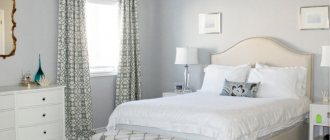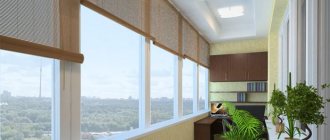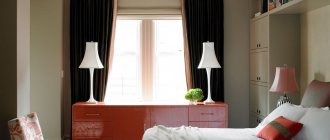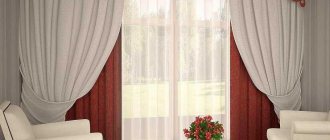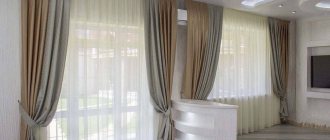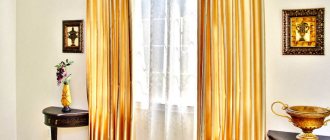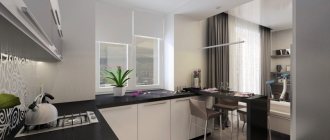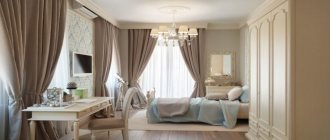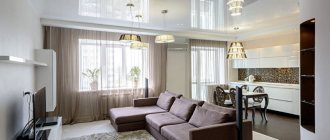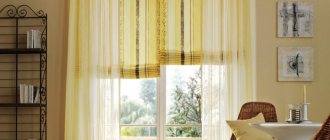Types of linen fabrics
Linen fabrics are made from flax bast, a part of the plant that plays a protective role. For this purpose, long-lasting and curly flax are used - special varieties of flax.
They are soaked, dried, crushed and subjected to scutching - the process of extracting fibers from primary raw materials. Textiles are made from long fibers, combs, and tows.
The following types of fabric can be purchased in stores:
- Furniture. Its density is from 380 g/m. The wear-resistant material is used for upholstering sofas and decorative pillows, making bags, potholders and shoes;
- Burlap. Refers to technical fabrics with a density of 360 g/m. Used for sewing durable suits and overalls;
- Curtain. This is a thin textile with a density of up to 100 g/m. It has less wear resistance, requires more careful care and is suitable for making curtains.
When selecting fabric, you need to take into account its characteristics and the location of future curtains. Some materials do not transmit sunlight well or have low resistance to damage.
Advantages and disadvantages of flax
Linen fabrics are made from natural raw materials and have positive consumer properties:
- environmental friendliness and safety;
- strength and wear resistance;
- good thermal conductivity and breathability;
- hygroscopicity (the ability to absorb moisture from the air);
- minimal electrification.
The disadvantage of such textiles is that they are difficult to care for. If you wash linen at a high temperature, it will shrink. It is difficult to iron it dry, because the material constantly wrinkles. When cut, the fabric falls off, which is why it needs to be processed again.
Types of linen curtains
Curtains serve to protect from sunlight or can be a decorative element. When choosing a product, it is important to focus on the purpose of the purchase: to darken the room or simply decorate the room.
Curtains
Initially, curtains were made of heavy fabric and were used to close the doorway. Nowadays this is the name for window curtains made from thick, opaque fabric. They are voluminous and block sunlight, creating twilight in the room.
Roman
Such products were widely used in the Roman Empire for protection from the scorching sun. Nowadays, Roman blinds are popular in countries with hot climates. They are a flat square canvas, laid in folds, secured with planks. Often installed in rooms facing the sunny side.
Blackout linen imitation
This is a light-proof material that drapes easily and retains its shape over time.
Partially absorbs the sun's rays, so on hot days the room heats up more slowly.
Curtains
Curtain is a curtain made of thin translucent fabric. Serves for decoration or practical purposes: covering a window or doorway, protecting from the sun and insects.
Rolled
These curtains are made of dense material and are designed to protect from sunlight. They are a structure equipped with a lifting mechanism, plastic fasteners and plastic hooks. When lifted, the fabric is rolled into a roll.
Linen curtains in the kitchen: practicality and beauty
Linen curtains in the kitchen emphasize not only the warmth in the interior, but also the good taste of the hostess. Linen is the most preferred material for the kitchen. Moreover, linen fabric can be used not only for finishing a window opening, but also in everyday life. To give the kitchen a special atmosphere and emphasize naturalness, an excellent solution would be additional products made from linen textiles - towels and aprons in the work area, and pillows, bedspreads, various covers and napkins in the dining area.
Linen goes well with kitchen furniture, especially if it is made of natural wood.
Pastel solid colors of linen curtains will suit different colors of walls and furniture. If desired, you can add a little decor to the fabric to increase the degree of beauty and grace. After all, the owners spend most of their time in the kitchen, eating or having guests, or cooking. And it is so important, when entering the kitchen, to enjoy the objects around you.
Linen is a very practical material that will fit perfectly into the kitchen interior and will be easy to care for.
To make your kitchen design stylish and interesting, you need to use the following recommendations::
- Curtains should not blend with the color of the wall;
- The color scheme of the curtains should be repeated in the kitchen decor;
- Non-marking curtain colors will only spoil the look of the window and the room as a whole.
The length of linen kitchen curtains is selected according to the preferences and desires of the owners. It is best to think carefully about the practicality of the curtains in advance, because... they should not interfere with opening the window at any time, but at the same time they should serve as good protection from the sun's rays and the prying eyes of passers-by in the evening.
When performing such frequent actions, it is advisable to opt for practical linen fabric that does not wrinkle from a light touch and is resistant to stains.
More and more often you can find Roman linen curtains. This choice of housewives is determined by their practicality.
Roman blinds are easy to quickly assemble if necessary or, conversely, cover a window opening with them; they do not interfere with kitchen work and are not afraid of water
A large assortment of fabrics will allow you to choose the best option for kitchen curtains in combination with your interior style. And for true needlewomen, sewing linen curtains with your own hands will not be difficult.
Curtain sizes
Before you buy and hang curtains, you should find out their size. To do this you will need a sheet of paper, a pen and a tape measure. To avoid mistakes, you can immediately install a cornice or other fastening.
The length is determined as follows:
- Measure the distance from the hook attached to the cornice to the floor.
- To eliminate inaccuracies associated with unevenness of the ceiling or floor, measurements are taken in 2-3 more places.
- If the curtains are attached not to hooks, but to grommets, loops or drawstrings, measurements are taken directly from the cornice.
Calculating the width of the canvases is more difficult. Since curtains often drape, measuring the distance from one hook to the other is not enough. The length of the product also matters.
Short
To find out the length of short curtains, you should measure the distance from the fastening to the window sill; sometimes it is worth going down another 15-20 cm. To determine the width of the curtains, measure the distance between the left and right curtain rod holders. The resulting number is divided by 2: this will be the minimum size.
Long
If the owner of the house wants long curtains, then he needs to add 30-50 cm to the results obtained during the standard calculation. The fabric will lie on the floor in lush folds. The maximum width is determined taking into account the coefficient of pomp of the fabric. For dense materials it is 2:1, for light materials – 3:1, for medium ones – 2.5:1. To get the final result, multiply the minimum size by the fluff factor (2, 2.5 and 3 depending on the type of fabric).
Style solutions for linen curtains
When choosing a style solution, take into account the design style of the room. Curtains are an important part of the interior, so they should not stand out from the overall composition.
Ecostyle
To create products in eco-style, natural fabrics are used. The predominant colors (both in textiles and in the interior) are green and yellow.
Scandinavian
The Scandinavian style is dominated by motifs of the north, sea and mountains. The products are designed in cool colors: gray, light blue, soft brown. To create curtains, take grayish or bleached linen, which has a smooth texture. An alternative option is thick fabrics decorated with marine patterns, anchors and ropes. This solution will help create a Nordic atmosphere in the room.
Country Country
If a house or apartment is decorated in a country style, all items contain rustic motifs. The latter depend on the national color of the country.
Provence
This is the style of provincial French cities. In this case, the internal walls of the houses are decorated with plaster, and warm colors predominate in the interior. The rooms are complemented by herbariums, forged elements, ceramic and porcelain figurines. Curtains made of loose fabric painted in pastel colors fit into this composition.
Classic
Products made in a classic style remain popular regardless of fashion trends. The curtains are made of thick material, complemented with tulle and tack, and are distinguished by elegant folds.
Modern loft in minimalist style
This style is elegant and minimal in detail, but requires a lot of space to create. Loft features: panoramic windows, high ceilings with built-in lamps, pastel colors and restraint. The room should not be overloaded with decorations, and the main emphasis is on lighting. Loft-style curtains are made of thin textiles and painted in white, gray or beige.
Linen curtains in the interior, in the bedroom, in the kitchen (6 photos)
Linen curtains in the interior, despite all their roughness, which is due to the natural texture, look very impressive. Decorating windows, balcony blocks or doorways with linen textiles gives the surrounding space a feeling of natural purity, spaciousness and graceful naturalness.
The history of the production of linen curtains goes back hundreds of years. Over this long period, people learned to make materials of different densities and reliefs from plant raw materials. This made it possible to use flax both for the production of thin linen tulle, which plays a purely decorative role in window design, and for curtains with a maximum degree of light protection and blocking cold air penetrating from the outside.
Depending on the method of weaving threads, finishing and colors, natural curtains are perfect for interiors decorated in a wide variety of styles.
Living room
It is better to choose linen curtains for the living room from thick fabric. If the curtains are an element of a multi-layer composition, a combination with other materials and decorative elements is acceptable.
- Thick curtains in coffee shades look very stylish, complete with an airy curtain made of the finest silk or cambric, with a lambrequin and holders in the form of intertwined cords of gold threads. This type of window design is perfect for a hall, where abundance and richness of details play an important role;
- The classic design of the living room implies symmetry, a lot of wood, natural finishes and calm shades. Linen curtains in a classicist interior can be light beige, plain, patterned, or match the color of the furniture. The main thing is that they are in harmony with other elements of home textiles, for example, with a linen tablecloth on the table, pillows or chair covers;
- In such “cozy” styles as country or Provence, the presence of all kinds of ruffles, bows and capes in the interior is warmly welcomed. At the same time, there must remain a reference to the natural nature of the material. In this case, linen curtains can be made from coarse fabric that imitates burlap and decorated with embroidery, lush frills or metal fittings.
Thin linen curtains in the living room
Linen curtains in the living room in Provence style
Bedroom
The bedroom is a room where comfort and tranquility should reign. It is very important for a good rest to be in an atmosphere that allows our nervous system to completely relax and does not create discomfort for visual perception. There is no place for eclecticism and eye-catching shades here. Pastel colors and naturalness, giving a feeling of freedom and peace, are the best choice for decorating a sleeping area. Linen in the interior fully meets all these requirements, which is what designers often follow when choosing decor for the bedroom.
- The ethnic style, which is gaining popularity in modern interiors, allows you to use items made of cotton, matting and, of course, linen in your decor. Japanese linen panel curtains look great, with which you can not only block out the light, but also, if desired, create comfortable diffused lighting in the room;
- For a bedroom designed in a strict Scandinavian style, it is unacceptable to overload the surrounding space with unnecessary elements. It is better to choose curtains with eyelets, in light colors and without frills;
- The original loft style, with brick walls and wooden beams, can also be effectively complemented with linen curtains. In this case, a deliberately rough texture of unpainted canvas, natural gray color and a minimum of accessories are optimal.
Linen curtains in a loft style bedroom
Japanese linen panel curtains
Kitchen
The kitchen space is a flight of fancy for creative people. Here, depending on your preferences, almost all styles are acceptable, except, perhaps, too elaborate Empire or Baroque. Classic, high-tech, Provence, ethno, country, art deco, Mediterranean, fusion - you can list the names for a long time, and in every interior there is a place for original and practical linen curtains.
Curtains for the kitchen must meet requirements that may not be so significant when selecting textiles for other rooms. They must be:
- not easily soiled;
- easy to care for;
- medium density;
- preferably not too voluminous and long.
Often the kitchen window is located in close proximity to the stove or sink, which, naturally, may not have the best effect on the appearance of home textiles. Please note that linen curtains cannot be “washed”, that is, only one piece of fabric on which, for example, a greasy stain has formed, can be cleaned. The entire product must be removed and washed. And frequent water procedures will not benefit natural fabric. Therefore, in the kitchen you can hang linen curtains, that is, made of artificial material, visually almost indistinguishable from the real thing, but much more practical in use.
More on this topic: curtains for the kitchen with access to the balcony
If you choose natural linen curtains for the kitchen, give preference to models in the form of Roman blinds or a simple curtain, which will allow the sun's rays to pass through well, filling the kitchen with warmth and comfort.
Thin linen curtains in the kitchen
Roman blinds made of linen in the kitchen
Linen curtains in the interior of different rooms: photos with examples
Adding curtains or other types of products to the window is one way to complement the interior and create soft lighting in the room.
Living room or hall
Classic options are suitable for decorating these rooms. Curtains can be combined with tulle - a light translucent fabric will soften the sunlight. Long curtains will visually increase the space.
Bedroom
Experts recommend choosing furniture and curtains in pastel colors. This composition has a calming effect and helps you fall asleep faster.
Children's room
The interior of the nursery is completely customized to the child: his gender, age, interests. Bright colors, cheerful motifs and decorations are important in a baby's bedroom. A teenager’s room is decorated taking into account the owner’s wishes, as it becomes the child’s little world.
To cover windows, you can choose either neutral curtains or products with an unusual print on the theme of space, animals, or sports.
Kitchen and dining room
The kitchen is first and foremost a work space. When selecting products, you should focus on their practicality. However, if the cooking area is combined with a guest area, you can hang curtains with tulle or two-color curtains with accessories: lambrequins, drawstrings and decorations.
Balcony and loggia
Many modern apartments have glazed loggias, which are mini-rooms. There you can put a work desk or arrange a corner for relaxation. For a balcony, roller blinds in a neutral color are best suited.
Wooden house or cottage
A wooden house or cottage is often decorated in country, eco or loft styles. The interior decoration should not be overloaded with details (furniture, statues, flowers), and the walls should not be overloaded with paintings and other decorations.
Terrace, veranda and gazebo
Outdoor curtains protect against insects, soften the effects of the sun's rays and retain heat during the evening or cooler seasons. In addition, they perform an aesthetic function: they decorate the structure, hide its shortcomings and emphasize its advantages.
If the resting place is glazed, decorative curtains made of thin textiles are suitable. For open spaces, you should choose curtains made of thick fabric.
Tips for choosing
When choosing linen curtains, you should listen to the advice of professional designers and ordinary people who “ate the dog” when decorating their homes:
- Linen goes great with cotton. Natural fabrics form an original multi-textured combination.
- To prevent curtains from wrinkling so much, you should choose linen fabric with the addition of viscose.
- Linen fabric, richly decorated with lace, is suitable only for ethnic trends. It looks outdated and is associated with typical interiors.
- Rough texture looks best on thin fabric. Translucent linen curtains are a must-have attribute of marine and Scandinavian styles.
- For the bedroom you cannot choose a material that imitates natural linen. If the composition contains synthetic fibers, then this will negatively affect the ability of the fabric to “breathe” and its environmental friendliness.
- If the curtains are decorated with a pattern, then it must echo the pattern on the upholstery or wallpaper.
- For country style, choose simple burlap curtains, which are decorated with openwork garters. This decorative attribute is easy to make with your own hands.
In modern styles, laconic plain floor-length curtains are more often used, which easily adapt to both wooden and metal surfaces in the interior.
Color design
Using different shades, you can create a Nordic, rustic, cozy or mysterious atmosphere in your home.
Grey
Gray colors predominate in Scandinavian style. It is recommended to hang smoky curtains or curtains in spacious rooms with large windows facing the sunny side. If the window is curtained with dark gray fabric, it should be combined with lighter elements or white tulle.
Green
Green curtains look good in almost any room: light colors are suitable for bedrooms, rich colors for the living room.
Shades of olives and pistachios will fit into the interior of a study (if there is one in the house), because they help you concentrate and set you in the right mood.
Beige
Beige curtains are in demand on the market, because people often decorate their homes in warm pastel colors. Products of this shade can be combined with options designed in other colors: gray, yellow, brown, white, soft blue. Colors should not be too dark, bright or toxic: this will make the room look pretentious and sloppy.
White
Before making a choice in favor of white light curtains, you should take into account the practical side of the issue. Such curtains get dirty easily, so it is better not to hang them in a house where there are small children. Also, do not place them near the work area in the kitchen, because this will make them dirty even faster.
In other rooms, white curtains will look appropriate, making the room lighter and more spacious.
Blue
Blue-colored products can be hung in a room decorated in almost any style, but they will fit most organically into Scandinavian, loft and country. Such curtains will visually expand a small room and decorate small windows. It is advisable to choose curtains in a soft blue shade.
Red
Red curtains will fit into a room decorated in a Gothic or Oriental style. This is a non-standard and extravagant solution: not everyone will decide to take such a step.
Long classic curtains and curtains in a rich red color look most impressive.
Brown
Brown curtains look good in a country house, in a country house or in a gazebo. They can also be hung in a bedroom or other recreation room, since dark dense fabric hanging from the mount to the floor will soften the sunlight and create twilight in the room.
Blue
Deep blue curtains look no less impressive than bright red ones. In addition, they produce a psychological effect: they relax, reduce aggression, reduce anxiety and help concentrate.
In the room you can hang classic products or spectacular curtains with prints of the sea, space, night city or starry sky.
Yellow
Yellow walls and curtains bring a special coziness, help you relax and unwind. Pale shades fit into the loft style, brighter and richer characters for eco and country. Yellow curtains, decorated with a pattern or a cheerful print, can be hung both in the kitchen and in the children's room.
Turquoise
Turquoise is associated with the sea and sky. Curtains of this color create coziness and evoke positive emotions. Fabrics in subtle turquoise shades will fit into the Scandinavian style, and classic curtains with a floral print go well with tulle.
Color palette of linen curtains for the kitchen
Linen curtains by their nature can only be in light shades. You can, of course, find brighter linen curtains for the kitchen, but this will be the result of chemical dyeing, which will reduce the level of environmental friendliness of the material. However, do not be upset, since the beauty of linen lies in the naturalness of its color, and light-colored canvases will fit very organically into the interior of any kitchen.
When choosing a color solution, you must consider the following:
- white color expands the space, but looks too cold and sterile;
- beige will perfectly replace white and give a cozy atmosphere:
- yellow color will bring a note of optimism to the interior, but it is better to use it in rooms where there is not enough light;
- green is a natural color, so linen fabric in this color will look absolutely harmonious, creating an aura of calm and tranquility in the kitchen;
- blue is suitable for too light and hot rooms, to which it will add coolness and freshness.
Design and drawings
Products with flowers or birds help you relax and lift your spirits. In addition, curtains can be decorated with lace, patterns, butterflies and other decorative elements.
With lace
The elegant pattern makes the product light and airy. These curtains are made of thin fabric and look great in a bedroom decorated in pastel colors.
Geometry, stripe, check
Checkered or striped curtains are a suitable option for those who value non-standard solutions. Curtains with geometric shapes, checkered patterns and stripes of different widths are suitable for decorating country-style homes. Creative personalities will be pleased with products with multi-colored stripes.
With flowers
Floral print is a solution that helps to achieve harmony with different styles: eco, country, modern. Using this design, you can create a romantic atmosphere and special comfort in your home.
Two-color
Two-color curtains are another non-standard solution for decorating a room. These can be curtains decorated with stripes of different colors, or a set of 2 curtains in different shades. The composition can be supplemented with a lambrequin.
With fringe
Fringe is a braid from which threads, laces, soft fibers and other pendants hang. This decorative element looks good in combination with classic linen products in different colors.
Features of linen fabrics
In addition to their natural origin, linen curtains have many other advantages:
- The high density of weaving allows them to trap dust from the street without impeding air movement.
- These curtains produce clear and smooth draperies. In addition, unlike synthetic curtains, they do not accumulate static electricity.
- Soft dispersion of sunlight - linen fabrics shade the room well, creating not twilight in it, but natural light that is more comfortable for the eyes.
- Microclimate regulation - our great-grandmothers knew that thick curtains provide warmth in winter and life-saving coolness in summer.
- Linen curtains have a dirt-repellent effect and therefore are easy to clean - ideal for a kitchen where textiles have to be washed much more often. They are also able to delay and partially absorb harmful radiation and have antibacterial properties.
Fabric selection and care
Although linen curtains are highly durable, they require careful care. It is recommended to wash them at a temperature no higher than +30..+40 °C using soft products for delicate fabrics. It is not advisable to spin the fabric in a centrifuge, otherwise there is a high risk that it will simply shrink after washing.
A serious disadvantage of linen, like other natural fabrics, is the difficulty of ironing. To ensure that such curtains always look flawless, as in the photo on the Internet, you will have to work hard. Therefore, do not leave the curtains just hanging after washing - they must be ironed with a very hot iron while they are still damp. And if you don’t want to bother with such a capricious material, to sew curtains with your own hands, you can choose a wrinkle-resistant mixed fabric with the addition of lavsan.
Pure flax is not only difficult to care for, but is also expensive. This problem can also be solved - just buy fabric with added cotton. Its price is significantly lower, the fabric itself is lighter and more airy, although its service life is noticeably reduced due to less resistance to wear.
Recommendations for cleaning and care
Before washing the product, you need to carefully shake it out or vacuum it. Linen can be washed on a delicate cycle without spinning or by hand.
How to iron and starch
Before ironing, the curtains are wrung out and attached to the curtain rod, after which they are dried until slightly damp. After this, prepare a special solution: 1 tbsp. l. starch is diluted in 1 liter of boiled water. The fabric is soaked in it and wrung out, after which it is gently ironed in the “linen” mode.
Features and advantages of cotton for curtains
Cotton is a natural material with a number of advantages:
- strength and durability;
- hygroscopicity;
- resistance to alkaline solutions;
- ease of care.
Disadvantages of cotton:
- weak elasticity;
- change in size and shedding during washing;
- poor resistance to sunlight.
Models and use of curtains made of cotton fabrics with photos in the interior
Modern models are distinguished by a variety of shapes, colors and design features. Cotton curtains can be hung in different rooms.
The classic version looks great in the living room.
In the children's room you can place curtains with an interesting print.
The kitchen will be decorated with bright eco-style curtains.
Burlap for curtains
Cotton burlap is a natural fabric that is often used to make curtains in eco, Provence or country styles.
Fabric properties
The fabric is 100% cotton, its density is from 200 to 400 g/m². Width – from 95 to 110 cm.
Advantages
Burlap is dense, has a porous texture, and allows air and moisture to pass through. Contains jute fibers, making it wear-resistant and has a long service life.
Models of burlap curtains in the interior
Burlap curtains fit into Provence, eco, country and classic styles. These can be cafe-style curtains or drapes attached to grommets.
Country-style curtains look good both in the interior of a country house and in the design of the kitchen of a city apartment.
Classic curtains with hinges are an option that will fit into almost any style.
How to choose linen fabric for curtains
This material has its own characteristics and comes in different finishes. Fiber for fabric is obtained from the skin of flax stems. It has been woven for several centuries; modern designers have also not ignored this beautiful, eco-friendly, hypoallergenic material and use it in modeling interiors in various styles.
On the one hand, linen curtains are easy to care for, since this fabric tends to repel dirt; on the other hand, to make the curtains look perfect, you will have to make a lot of effort to iron them, but the efforts will be justified, since ironed fabric does not wrinkle easily.
We produce unbleached, bleached linen, and with additives. The choice of fabric for linen curtains depends on the style of the interior of the living room or other room - all three types have different textures, and, of course, different shades and shine.
Unbleached linen imitates homespun fabric; this fabric has a slightly dusty gray-brown tint. Its texture is a clearly visible interweaving of threads. It is used when decorating interiors in Scandinavian minimalism, rusticism and other styles, the task of which is to recreate closeness to naturalism.
Lightened linen has shades of gray-white, beige, and milky white. Thin curtains with lace made of lightened linen look warm and airy - they will create a particularly light and homely atmosphere in country, Provence and grunge styles. A thick fabric with a pronounced relief is perfect for decorating both a living room and a bedroom - preserving the natural beauty of a natural material, this linen fabric looks expensive, it is used in interior design in modern and gothic, as well as in African style.
Linen fabric is also produced with additives - lavsan or silk thread. This luxurious fabric has the property of shimmering.
It fits organically into the art deco style - in rooms of this design, rounded shaped interior items are used: heavy matte shiny folds of linen come in very handy here. Linen with lavsan and silk is good in both classical and antique styles - where the spirit of aristocracy and sophistication should be in the air.
When choosing fabric for curtains, you need to pay attention to the pattern. If the room is in an antique style, there should be a Greek ornament, and in Slavic, colonial and oriental interiors, a floral print is appropriate.
Types of matting curtains
Classic and Roman blinds, drapes and curtains are made from this fabric. In addition, they are divided into different types depending on the attachment to the cornice and the style in which they are made.
Material characteristics
Matting is made from wool, cotton, linen and silk. To give the fabric strength, synthetic threads made of polyester and acrylic are woven into it. Density – from 110 to 195 g/m².
Curtains: linen in combination with other types of fabrics
There is ultra-thin linen - a fabric that is used in the form of tulle, a translucent breathable material, suitable for cozy bedrooms and calm classics, it can be used in almost all styles, except for panels and designs in luxurious classics from IKEA.
Flax with additives represents:
- Additional threads are added to the material to prevent excessive creasing and to add gloss and shine;
- Recently, linen with the addition of gold threads has begun to be found;
- The material gives a special solemn look to the room.
To complete the window design, such curtains are often decorated with embroidery on the fabric, woven ribbons or lace - depending on the room and the chosen style of the room or kitchen.
It is important to remember that curtains should not blend in color with the walls. This article will help you choose the right ones for your interior:.
The shade should combine well with the rest of the color scheme of the room, and it also looks good when the color scheme is repeated somewhere else - decorative pillows, chair covers or aprons and towels, if we are talking about the kitchen. It is important to remember that an excess of decorative elements for linen fabrics and cotton is destructive. You definitely can’t use DIY ideas, lambrequins, pearls, beautiful rhinestones and other glamorous accessories and drapes with them. The use of linen materials on windows in Baroque, Rococo and rich classic styles is not recommended.
Design and photos in the interior of matting curtains
Matting is an environmentally friendly and safe material. Curtains and drapes made from this fabric are often used in classic or Scandinavian room design.
Curtains in green and yellow colors perfectly complement the rest of the eco-style interior elements. A blackout option made from matting is popular - such products are dense and protect from the bright sun.
Linen curtains in different interior styles
Mediterranean or Provençal. Curtains made from this amazing material are recommended for those who are working on creating a Mediterranean-style interior. Bleached linen with a yellowish tint will fit perfectly into the dominant olive-violet color scheme. The density of the fabric is selected in accordance with the upholstery of the furniture and the degree of “simplification” of the room.
Scandinavian. To create a Nordic spirit in the room, we recommend thin bleached linen with prints or braiding with a nautical theme, or thick, imitating canvas, which fits perfectly with deliberately simple furniture and thematic decorations - lamps on the windows, a collection of anchors and harpoons.
Eco. An interior that gives preference to natural materials will be an ideal haven for linen curtains. The density and color of textiles depends on the theme that dominates the room. Selected in accordance with other materials - cork, leather, green walls, wood and stone used by the designer.
Folklore. The interior of any folk style - from Russian to Mexican, Vietnamese or Japanese - can be emphasized with linen curtains. The shade and texture of the fabric is selected in accordance with the color scheme chosen for the room. In some cases, in an African or Asian interior, it is recommended to add textiles with prints, appliqués or hand embroidery.
Fusion This modern style pairs beautifully with simple linen drapes.
General contraindications for linen textiles are the following:
- Firstly, linen does not tolerate an abundance of decorative details.
- Linen curtains do not require lambrequins, boots or linings.
- Such products are used very carefully in frankly luxurious interiors - modern, baroque or empire.
The thoughtful use of linen curtains in the interior will allow the designer to realize his plans, as well as achieve a note of elegance and special sophistication in rooms made even in folk style.
How to sew curtains from natural fabrics with your own hands: manufacturing instructions
To sew products for window coverings yourself, you need to decide on a style, take measurements, and purchase fabric.
After this, you can move on to the main work:
- Set up the sewing machine: install a new needle, select strong threads, set the average stitch length (3-5).
- Adjust the presser foot pressure and thread tension. The height of the rack teeth must be adjusted so that the fabric does not bunch up during operation. If these conditions are not met, the textile will be pulled together with a seam.
- The edges of the curtain can be processed in 3 ways: rolled seam, bias tape or hem.
To sew curtains yourself, you will need not only a good sewing machine, but also skills and dexterity. You should start with the simplest options and after mastering this, try to sew Roman blinds and other unusual options.
